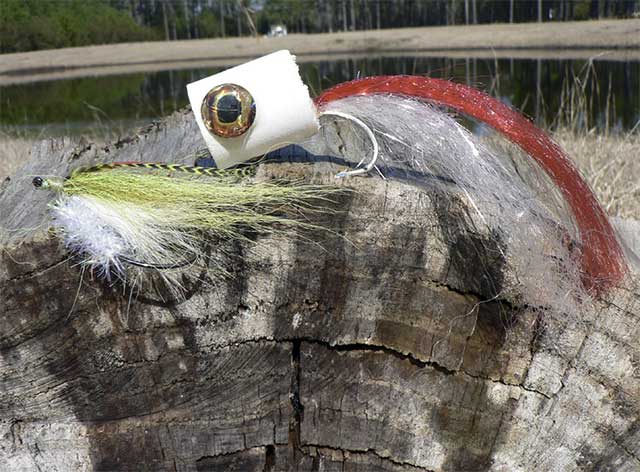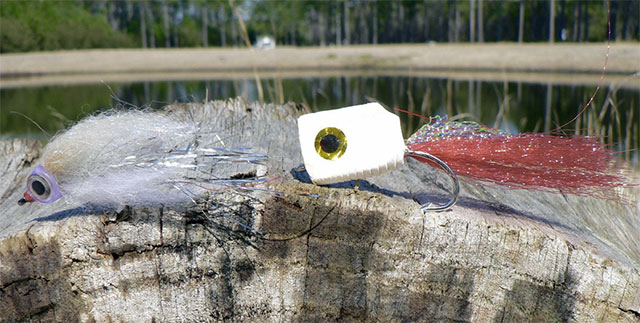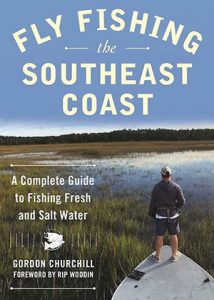“Unique Flies I Use”

The Critter tied on a plastic worm hook for weedless fishing and the B.A. Popper for B.A. fish.
I was solo poling my skiff from the bow. The flat was pretty much in the backyard of some fancy houses and a family I knew was out watching me and saying hello. I looked to my right and I saw a tail pop up, probably the biggest one I had seen all summer. It was September and the tailing season would be over in a few more weeks. I was able to cast to this fish from my boat that I had positioned behind a fallen tree. This would help to mask my position. The cast seemed good, but the fish had changed direction while the fly was in the air. At this point I had to wait until the fish moved away before I picked up to recast so as not to spook it. I cast again and this time it was right on. The fly was barely visible, and I was able to watch the fish swim over, open its mouth and suck it in. It was beautiful! For some reason I was only using my 6-weight when I usually use an 8-weight. Also I only had 10-pound tippet where I would usually use 15. So I had to be extra-careful with this fish, plus I had to keep it away from the branches of the same tree that had masked my position. Oh, the irony was dripping. When I got the fish to hand it was a gorgeous specimen and all was right with the world.
Critter Fly
My favorite inshore redfish fly is one that was dubbed the Little Crabby Critter by some guys on an Internet forum a few years back. These days I just call it The Critter. It’s a tail made of craft fur, a wrapped body with rubber legs, and a wing of some kind. Again, as you’ll notice with my flies, the basic simplicity of the design gives an infinite combination of choices. You’ll see tiers who have “invented” this fly all over the place, time and again. It’s nothing new, but it works because of the ability to change the colors and materials without getting locked into a specific “pattern.” If you’re fishing over light sand, you can use a tan color; in clear water over dark bottom, then white works great; in murky water, brighter colors get the nod. The same basic design can work in any of those situations.
I have caught all the typical inshore species on them—reds flounder, trout, stripers. It’s just a way of looking at the inshore environment and being prepared for the situations you will be encountering. Using a plastic worm hook allows this version to be fished weedless in situations that call for it. If the water is a little deeper, I can add some lead wrap to the shank. If it’s shallow, I leave it alone. Again, have them prepared ahead and be ready to switch as needed.
B.A. Popper
The amberjacks were lighting up the screen on the depth finder. We simply could not get a bite. I was fishing a streamer fly on a sinking line. They would follow it up through the water column and turn away at the boat. It was the same thing with jigs on a spinning rod. I decided, kind of on a whim, to try a Big Ass Popper I had sitting in my fly box. My buddy, Captain Tom Roller, told me to try it. I had another rod with a floating line already rigged.
The first time that popper hit the water and started making some noise it was like a dinner bell ringing. Those jacks could not help themselves, and I would get three or four hits per retrieve sometimes. We caught them that way until we were too tired to do it anymore. There’s something about the gurgling noise that makes those amberjacks decide now is the time to eat. It’s amazing really.
The B.A. Popper is easy to make. You can get the bodies at any fly or craft shop, although they’ll be much cheaper at the craft shop. Get the 1-inch diameter hard foam popper bodies. You may have to do some trimming to get them to fit on whatever hook you have. A 4/0 or 5/0 hook with a long, flashy tail made of Ultra Hair or some other long synthetic material will work. Don’t use bucktail. It’s too expensive and it’s not needed here. It’s the noise and the profile these fish can’t resist.
Laser Minnow
The albies were firing on all cylinders, but I just could not put it together. I’d get a bite, fight the fish, and it would come off. I’d make a good cast, and the fish would come up, look at my fly, and not commit. I was snake bitten. I told my friend Chris to get up there before I went kind of crazy. He got one good shot and I saw his fly get devoured instantly. We got that one in and I told him to do it again, so he did. Now I had to know, what’s the deal? His fly was almost a dead ringer for the little silversides. The material seemed to hold light differently. I had to have one. I beat Chris up with a bat I carry in the boat for just such purposes and, well, not really. Chris gave me one unbidden because that’s the kind of guy he is. I immediately hooked up, so the story had a happy ending with no broken bones.
Senyo’s Laser Dubbing is a new material to me. Apparently, it’s been around for a while, I just missed it. It makes a really nice baitfish fly that the albies seem to enjoy. Believe me when I say almost anything will work on these fish. When they are feeding, the most important thing is to get your fly in front of their faces. They’ll probably eat it. A big part of it too is having confidence in whatever you have tied on. If you feel good about your fly, you’ll probably fish better. It’s the same as a golfer with a lucky putter or a concert violinist with his favorite bow. Anything would work, but that special thing just makes it better. The original Laser Dub is only 2 inches long, but now they make a version called Bruiser Blend with longer fibers that will make a bigger fly.

The Laser Minnow tied with Senyo’s Laser Dub and a homemade popper that will work for bass, redfish, and speckled trout.
Homemade Popper
This was a new pond, well, new for me anyway. A friend had told me about it. Cool. I’ll give it a shot. On my second cast a 5-pound bass came out of nowhere, jumped once, then ran my leader under a drainage pipe and busted me off, all in about three seconds. Ugh. I spent the next hour and a half having a great time catching fish after fish in the 13- to 18-inch range on my 6-weight rod. The small poppers I had made on size-4 hooks with the craft-fur tails seemed to be a delight for these fish, which delighted me as well.
Summer evenings, fly-rod poppers, and bass ponds were made for each other like Clapton and the blues. Casting a popper into a bass pond while the frogs and crickets conduct their symphonies makes a summer day melt into perfection. I came up with this one day while I was messing around with a piece of foam I had lying around. It’s not an earth-shattering innovation, it just shows what you can do when you have various materials around and a problem to solve.
I started cutting it up with a pair of scissors until I had a shape I liked, then poked a hole through it with a fly-tying bodkin. Secure the whole thing onto a predressed hook using some super glue and that’s it: simple and effective. I got a 3-pounder on it the very first time I took it out. Get the foam blocks or cylinders that are available at any craft store. I like to whittle them with scissors. They make a nice gurgle sound that the fish like too. Sometimes you might end up with one that doesn’t quite work. It’s all part of the ongoing experiment.
Excerpted with permission from Fly Fishing the Southeast Coast: A Complete Guide to Fishing Fresh and Salt Water (Skyhorse Publishing, April 2017); all rights reserved.












